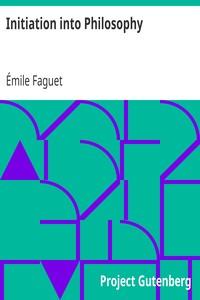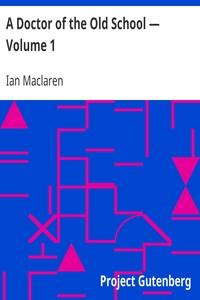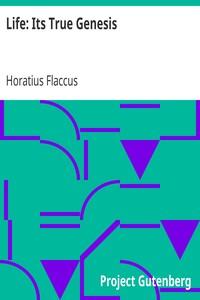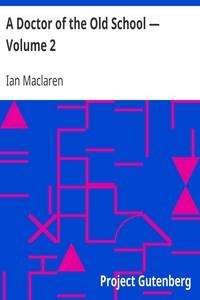Read this ebook for free! No credit card needed, absolutely nothing to pay.
Words: 83839 in 12 pages
This is an ebook sharing website. You can read the uploaded ebooks for free here. No credit cards needed, nothing to pay. If you want to own a digital copy of the ebook, or want to read offline with your favorite ebook-reader, then you can choose to buy and download the ebook.
Prefatory
Preface to Second Edition.
Here is the law of life, as laid down by the eagle-eyed prophet Isaiah, in that remarkable chapter commencing, "Ho, every one that thirsteth"--whether it be after knowledge, or any other earthly or spiritual good--come unto me and I will give you that which you seek. This is the spirit of the text, and these are the words at the commencement of the tenth verse:
"As the rain cometh down, and the snow from heaven, and returneth not thither, but watereth the earth, and maketh it bring forth and bud , that it may give seed to the sower, and bread to the eater : so shall my Word be that goeth forth out of my mouth ; it shall not return unto me void , but it shall accomplish that which I please, and it shall prosper in the thing whereto I sent it."
This formula of life is as true now as it was over two thousand six hundred years ago, when it was penned by the divinely inspired prophet, and it is as true now as it was then, that "Instead of the thorn shall come up the fir tree, and instead of the briar shall come up the myrtle tree; and it shall be to the Lord for a name, for an everlasting sign that shall not be cut off." That is, as the rains descend and the floods come and change the face of the earth, a law, equivalent to the divine command, "Let the earth bring forth," is forever operative, changing the face of nature and causing it to give expression to new forms of life as the conditions thereof are changed, and these forms are spoken into existence by the divine fiat.
In all the alternations of forest growths that are taking place to-day, on this continent or elsewhere, this one vital law is traceable everywhere. In the course of the next year, it will be as palpable in the Island of Java, recently desolated by the most disastrous earthquake recorded in history, as in any other portion of the earth, however free from such volcanic action. On the very spot where mountain ranges disappeared in a flaming sea of fire, and other ranges were thrown up in parallel lines but on different bases, and where it was evident that every seed, plant, tree, and thing of life perished in one common vortex of ruin, animal as well as vegetable life will make its appearance in obedience to this law, as soon as the rains shall again descend, cool the basaltic and other rocks, and the life-giving power referred to by Isaiah once more become operative. There is no more doubt of this in the mind of the learned naturalist, than in that of the most devout believer of the Bible, from which this most remarkable formula is taken.
We have no disposition to arraign the American and European "Agnostics," as they are pleased to call themselves, for using the term "Nature" instead of God, in their philosophical writings.
When they tell us, for instance, that a toad has hibernated for a million years in any one of the stratified rocks near the surface of the ground, we interpose the objection that none of these batrachian forms can exist for a period of more than twelve months without air and food. And yet they have been blasted out of cavities in the surface rocks of the earth, where they have apparently lain for the period named by our scientific friends referred to. The fault is not ours, but theirs, that they are in error. Had they determined to study the subject of life, as we have done, from the Bible as well as from nature, they would have commenced at these toad-producing rocks, and worked their way upward to the source of all life, and not downward to the vanishing point--that where animal life ceases in the azoic rocks. The batrachians are low down in the scale of nature, but they have a determinate period of existence, as do all other forms of life. Try your experiments with them; see how long they will live without light, air, and food. This you can do as well as ourself. Conform to all the conditions required--the absolute exclusion of light, air, and food--and you will find that the toughest specimen experimented with is a dead batrachian inside of one year.
This experimental test should settle the question of lengthened vitality between us. There is no miracle about this matter at all, and science finds no stumbling-block in the way of a complete explication of this riddle, if, in the light of nature, there be any such riddle. We claim there is not, when we interpret nature in the light of nature's God. Let the earth, or rather its silicious and other decaying rocks, bring forth these batrachian forms. The command is imperative and not dependent upon any "seed" previously scattered or sown in the earth itself.
The parent toads bury themselves in the gardens and ploughed fields in the early autumn, and if they survive the severity of the winter months, may propagate their kind the second year, and probably for several years. But they require remarkably favorable conditions to continue their life for any considerable number of years in open-field propagation, while under no circumstances whatever can they make their way into these decaying rocks in order to propagate their species. The reason why such fresh specimens appear under these circumstances, and in the cavities of the rocks named, is conclusively that indicated by the prophet Isaiah, in the text quoted by us; and when Professor Agassiz was forced to admit that trout must have made their appearance in the fresh-water streams emptying into Lake Superior, instead of originating elsewhere, it is to be regretted, for the sake of science, that he did not boldly enunciate the formula of life as taught by the eagle-eyed prophet of the Bible, and not as proclaimed by the owl-eyed professors of the London University College.
What is true of the trout in these Lake Superior streams, is true of them almost everywhere, even right in the town of Cheshire, Conn., where we are inditing this preface, the 10th day of October, 1883. We recently visited the Rev. David D. Bishop, in the northeastern portion of this township, where that cultured gentleman was constructing an artificial trout-pond. It was at a season of the greatest drought known for years in that portion of the town.
The point selected for this trout-pond was at the farthest eastern source of what is known as "Honey Pot" brook in Cheshire, a famous one for trout in former years. Mr. Bishop proposed to stock his pond with the best spawn he could procure. We remarked to him that there was no need of that expense, as no stream ever produced better trout than the "Honey Pot"; and on closely examining one of the six or eight cold springs developed in his enclosure, to his surprise, not ours, we discovered several small trout, not more than six weeks old, as lively as they could well be under the blasting operations then going on there; while his children were fishing out from the rocks any number of young frogs , abounding wherever rocks and water make their appearance in similar localities. This incident was all the more remarkable for the reason that this small stream, or rather source of one, had been apparently dry for months, as had been many of the best wells in the town.
Free books android app tbrJar TBR JAR Read Free books online gutenberg
More posts by @FreeBooks
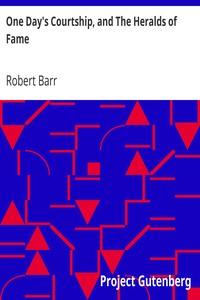

: Initiation into Philosophy by Faguet Mile Gordon Home Translator - Philosophy Introductions Philosophy
